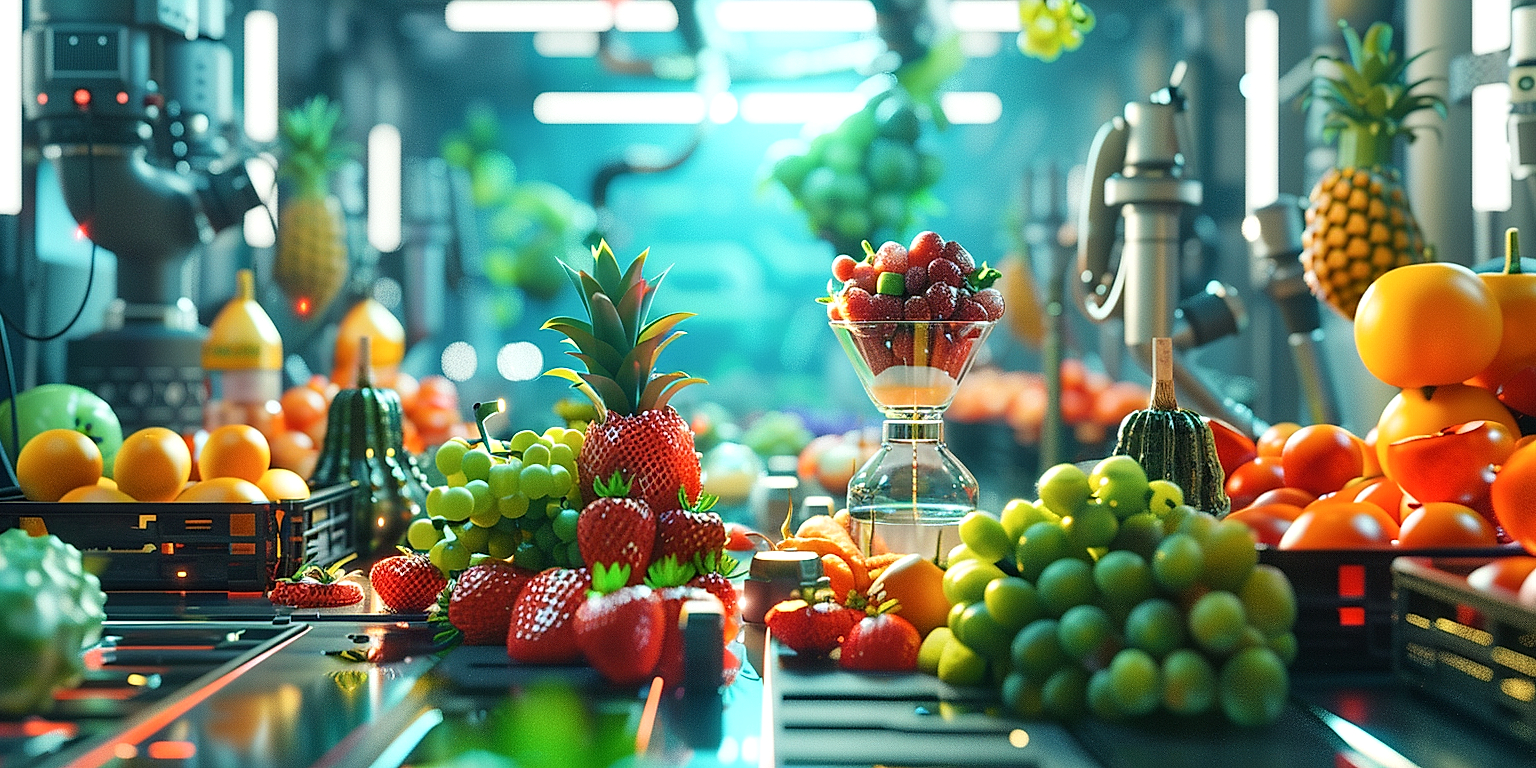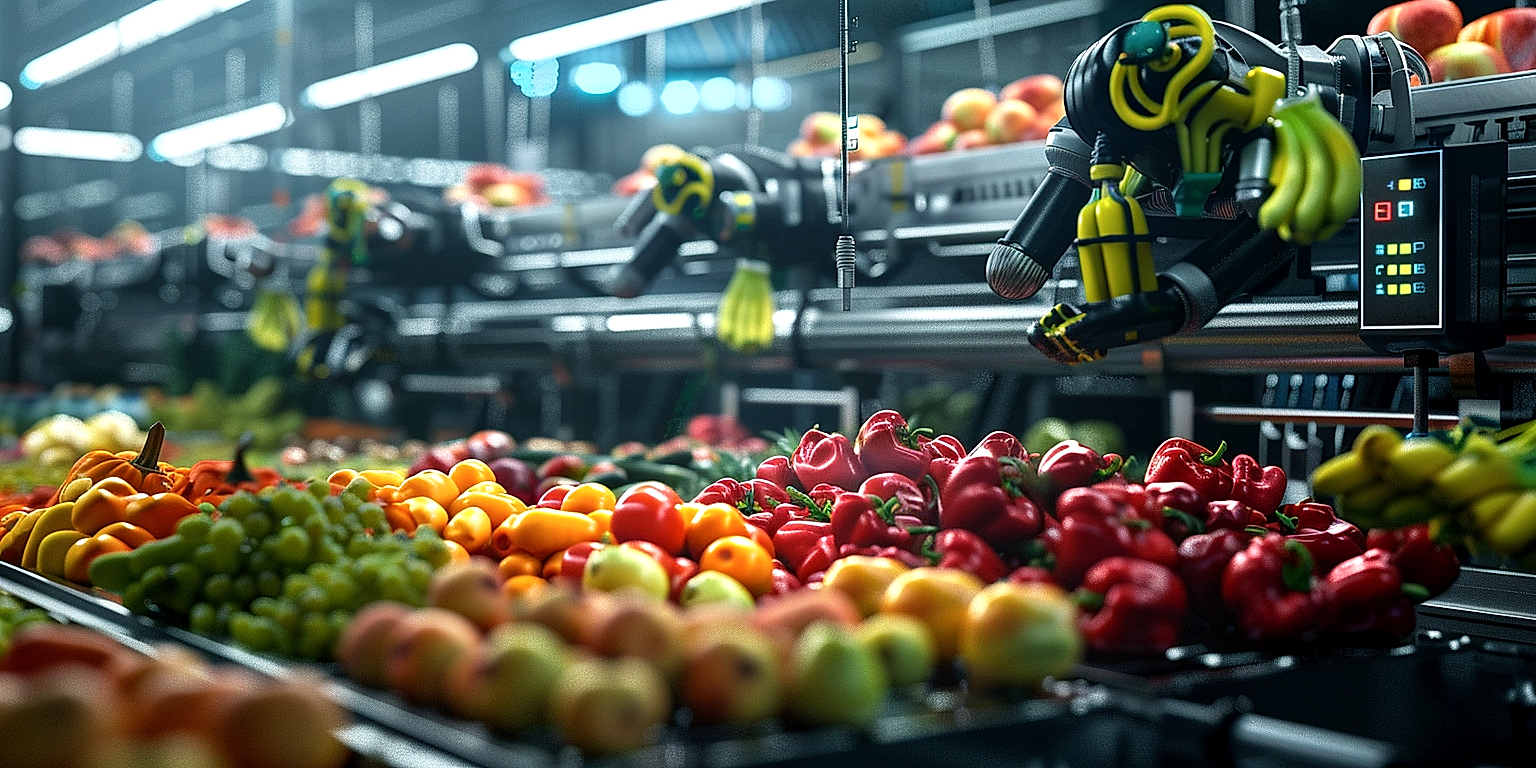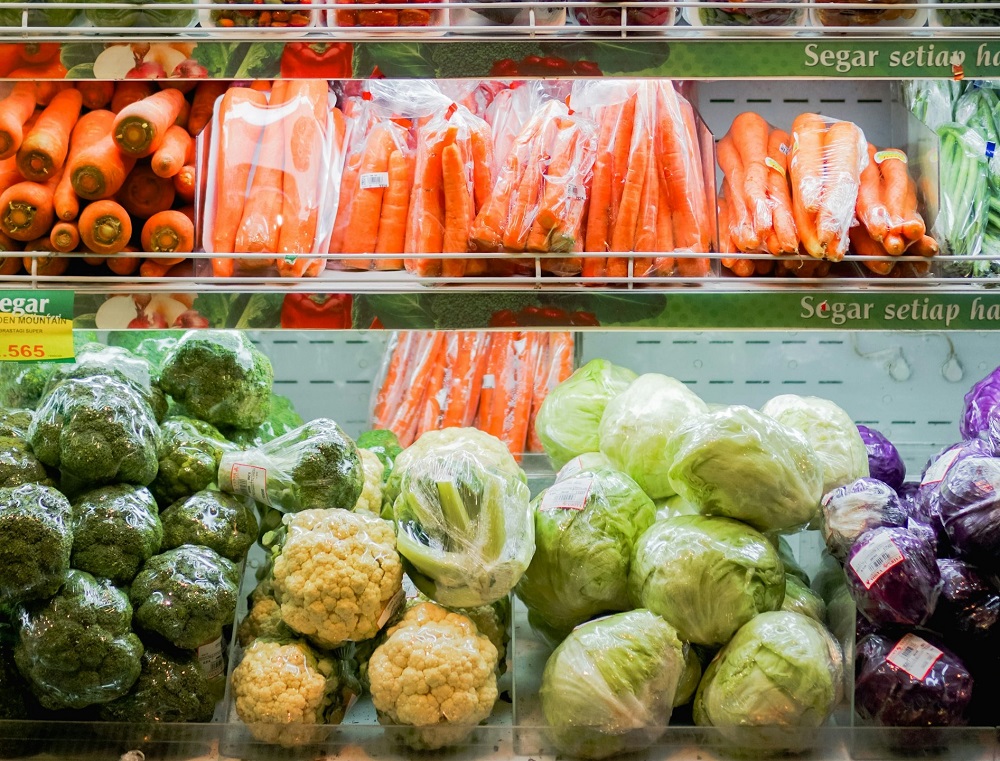In the dynamic sphere of produce processing and logistics, the role of technology cannot be overstated.
Over the past few years, we have seen significant advancements in artificial intelligence, machine learning, and robotics.
These advancements are directly impacting the sector, augmenting efficiencies and redefining longstanding procedures.
This progress is merely an indication of the immense potential that technology holds to transform logistics in produce processing.
The logistics landscape is now evolving at an unprecedented speed, consistently adapting to ever-changing consumer demands and market conditions.
To stay competitive and optimize operations, incorporating such innovative solutions is no longer an option, but a necessity for businesses operating in this domain.
Technologies Transforming Logistics In Produce Processing
1. Blockchain Technology for Traceability and Transparency
The revolution of the logistics industry is currently underway, with technology taking the lead role in transforming various processes, and blockchain technology is one of the key innovations driving this revolution.
Essentially, blockchain is a digital record or ledger of transactions that is distributed across an entire network of computer systems.
Each block within the chain contains a number of transactions, and every time a new transaction occurs on the blockchain, a record of that transaction is added to every participant’s ledger.
This unique and innovative system provides an unmatched level of traceability and transparency, making it an ideal tool for the logistics industry.
In the context of logistics and specifically produce processing, blockchain can provide a complete digital trail of a product’s journey from farm to table.
This is a game changer as it not only ensures food safety but also builds consumer trust in the products they consume by offering visibility into its origin, handling, and authenticity.
Moreover, blockchain technology allows for proof of origin, ensuring that each piece of fruit, vegetable or other agricultural product has been responsibly sourced.
Various produce processors are already implementing blockchain to boost traceability and transparency, reducing the time it takes to trace produce back to its source from weeks to mere seconds, an aspect that is particularly critical in events of foodborne disease outbreaks.
This improved traceability also means that in case of a food safety issue, companies can engage in targeted recalls instead of mass withdrawals, saving considerable time, effort and resources.
Blockchain also works as an effective deterrent to fraudulent activities that are prevalent in the supply chain such as counterfeiting, as every transaction is recorded and cannot be altered once validated by the network participants.
Additionally, blockchain can facilitate smart contracts — automatic, self-executing contracts with the terms directly written into the blockchain code thereby speeding up payment processes and reducing disputes.
Despite the multitude of benefits, the adoption of blockchain in produce processing is still nascent with challenges such as standardization needs, technological complexity, understanding of the technology, and regulatory considerations hampering its widespread use.
However, experts predict that as these issues get sorted out and awareness grows, blockchain technology will eventually become a mainstream tool for ensuring traceability and transparency in the logistics of produce processing and beyond.
In short, blockchain is set to have a profound impact on the logistics industry, with its ability to foster a safer, more transparent, and more efficient supply chain from the farm to the end consumer.
2. Robotics and Automation for Sorting and Packing
As the global demand for speed and efficiency increases, the use of robotics and automation in the logistics of produce processing has become inevitable.
These technological advancements are set to revolutionize the sorting and packing processes in the industry.
Conventionally, these tasks were manual and labor-intensive, leading to low productivity and increased susceptibility to errors.
However, the advent of robotics and automation has significantly improved efficiency and reduced the necessity for human intervention.
Robots can work round the clock without fatigue, thus offering increased productivity as compared to human labor.
The use of machines also allows for a high degree of accuracy in sorting and packing, significantly reducing waste due to mishandling.
Furthermore, automation enhances safety in the workplace by undertaking tasks that could potentially be hazardous to humans.
By utilizing advanced sensors, computer vision techniques, and algorithms, these machines can identify and sort different types of produce based on pre-set parameters.
Aspects such as the size, color, shape, and ripeness of the produce can be analyzed accurately through robotics and automation.
Automatic packing machines, on the other hand, ensure that all produce is packed consistently and to the desired quality standards.
This not only improves customer satisfaction but also boosts brand reputation.
Moreover, companies that have adopted this technology gain a competitive edge in the market through demonstrating their commitment to innovation and ensuring optimal resource utilization.
It is also worth noting that the gradual introduction of robotic systems in the produce processing industry is aiding in the struggle against increasing labor shortages.
Despite the initial investment costs, businesses stand to benefit from cost savings in the long run due to increased efficiency, productivity, and reduced waste.
Overall, the incorporation of robotics and automation in the process of sorting and packing is a technological breakthrough that holds immense potential for transforming logistics in produce processing.
3. Internet of Things (IoT) for Inventory Management
The Internet of Things (IoT), once a futuristic concept, is now an integral part of logistics in produce processing industries.
IoT entails the interconnection via the Internet of computing devices embedded in everyday objects, enabling them to send and receive data.
In terms of inventory management, IoT plays an indispensable role in automating processes and providing real-time data.
This technology not only enhances accuracy but also increases efficiency in inventory management.
IoT devices, such as sensor-based systems, provide real-time updates about the condition, location, and status of inventory, resulting in minimized wastage and maximized utilization of resources.
These devices come equipped with sensors that can tell when a product is about to go bad or when a particular product is running low in stock, leading to prompt restocking.
Fresh produce requires a strict check over its quality, temperature, and humidity levels during storage, and IoT ensures continuous monitoring of these parameters.
For example, sensors attached to the goods in storage can send alerts if the temperature or humidity crosses the desired thresholds, allowing necessary actions to be taken to prevent spoilage.
IoT is also used to implement First in, First out (FIFO).
RFID tags or barcode scanners read the entry and exit times of products, thereby ensuring that warehouse managers can keep track of the shelf life of the inventory.
Thus, the oldest stock gets sold first, reducing the overall wastage of perishable goods.
Additionally, IoT can increase efficiency in produce processing by integrating inventory systems across multiple locations.
This eliminates the need for manual checks and facilitates the automatic update of stock levels, optimizing the entire supply chain.
Through the use of IoT, the production rates can be adjusted based on the actual demand from the market, thereby reducing the possibility of overproduction or underproduction.
Smart logistics systems also use IoT to trace lost products,
This not only reduces losses due to misplacement of goods but also improves the traceability of the products.
In brief, IoT, with its ability to collect, analyze, and communicate data in real-time, is becoming pivotal in advancing inventory management in produce processing, ultimately leading to an optimized and efficient logistics system.
4. Machine Learning for Predictive Demand Forecasting
Machine learning is rapidly becoming a cornerstone of transformation in many industries, including logistics in produce processing.
One of the most significant areas where it has shown immense promise is in the realm of predictive demand forecasting.
This technology uses complex algorithms to analyze vast quantities of historical and real-time data to create accurate predictions about future demand trends.
With such detailed, accurate forecasts, businesses can better manage inventory, production, shipping schedules, and resource allocation.
As a result, waste is drastically reduced, supply chains are optimized, and productivity is significantly increased.
Machine learning’s ability to accurately predict future demand trends impacts inventory management, shipping schedules, and resource allocation, dramatically boosting productivity.
The key to successful demand forecasting lies in the quality and diversity of the data fed into the machine learning algorithms.
These can include historical sales data, market trends, economic indicators, weather patterns and even social media sentiments.
An additional benefit of predictive demand forecasting using machine learning is its capability to continuously learn and improve with each computation.
As it is exposed to more data over time, the machine not only improves the accuracy of its predictions but also reveals hidden trends and patterns that manual analysis may not have been able to uncover.
This can provide businesses with deeper insights into the behavior and preferences of their consumers, enabling them to cater to their needs more effectively and stay ahead of competition.
Indeed, with accurate demand forecasting, businesses can now address a long-standing issue in the logistics of produce processing – the problem of perishability.
By getting an accurate estimate of the demand, the amount of produce to be processed can be determined more efficiently, hence reducing the risk of overproduction and waste.
At the same time, it helps prevent underproduction, ensuring that consumers’ needs can be met without any shortage.
In addition, machine learning can assist in managing the delicate balancing act of seasonal produce – helping to plan for periods of increased demand and prevent stockouts.
The advancement of machine learning and its integration into demand forecasting represents a paradigm shift in the logistics of produce processing.
The ability to more accurately predict future demand not only reduces costs and increases efficiency, but also leads to improved customer satisfaction and a more sustainable business model.
5. Drones and Automated Vehicles for Efficient Delivery
The advancement in technology has led to the integration of drones and automated vehicles in the logistics of produce processing.
These technologies offer the potential to transform the efficiency of delivery processes, particularly in terms of speed and cost.
Particularly, drones have the advantage of being able to deliver perishable goods quickly without being hindered by ground-based traffic.
This is of great benefit in the logistics of produce processing where the timeliness of delivery can greatly affect the quality of the produce.
In addition, the use of drones reduces the human intervention needed in the delivery process, reducing the risk of errors or damage to the produce.
Moreover, automated vehicles have the potential to revolutionize land-based delivery, offering a cost-effective solution that can operate around the clock.
The use of self-driving trucks for long-haul deliveries can significantly reduce the transit time, thereby enhancing the freshness and quality of the produce upon delivery.
Also, automated vehicles have embedded intelligent systems capable of optimizing delivery routes to save time and fuel, contributing to an overall more efficient and sustainable logistic process.
The implementation of such vehicles in logistics is expected to cut down on labor costs, making the whole system more cost-efficient too.
Moreover, these delivery methods reduce the carbon footprint associated with produce delivery, aligning with global efforts towards reducing carbon emissions.
While both drones and automated vehicles hold great promise, there are regulatory hurdles and logistical challenges that must be overcome before they can be widely adopted.
These include addressing safety concerns, creating infrastructures that support these technologies, as well as formulating regulations and guidelines for their use.
Only then, drones and automated vehicles can truly serve as transformative forces in the logistics industry within the sphere of produce processing.
Therefore, thorough research and innovation are essential to harness the potential of these technologies for transforming logistics in produce processing.
The Bottom Line
Technology is swiftly reshaping the way businesses function, contributing to new efficiencies and possibilities in the modern supply chain.
Innovations such as blockchain offer excellent opportunities to elevate traceability and transparency, while developments in robotics and automation are revolutionizing sorting and packing processes.
The Internet of Things is creating novel approaches to inventory management, and Machine Learning is increasingly utilized to build predictive demand forecasting.
Additionally, drones and automated vehicles are promising a future of quicker and more efficient delivery.
Thus, it is unequivocal that the integration of advanced technologies is not only transformative but essential for the evolution of supply chain management.




